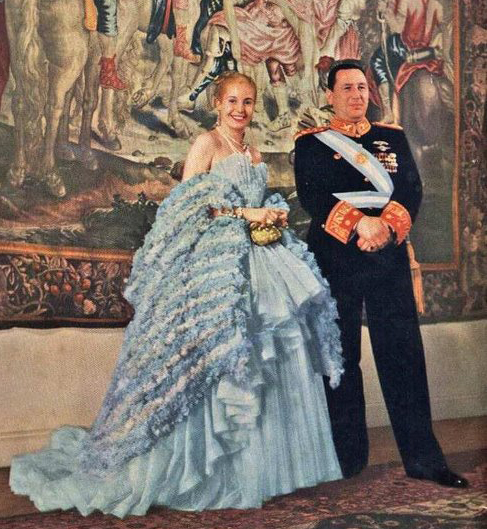Peron and the Second Coup D’etat

Evita and Juan Perón in 1947: Archivo Gráfico de la Nación Argentina.
Peron’s wife Eva was born in poverty, which gave her a strong sense of justice, and when she was 15 she moved away from a very hard childhood to Buenos Aires to pursue a career as an actress. It was during a charity event that she met Peron and the two were married a year later. During Peron’s first presidential reign they were a power couple, with Eva taking over the unions and founding her own female political party.
“Eva was married with her ideas, she was extreme, and in some way the only way of fighting the landowners. Eva and Peron were much more than a couple but the alliance between the labour unions and the army. Peron was the Army, and Eva was the unions. So, they made that alliance. The army hated Eva Peron and the unions felt better with Eva than with Peron.”
According to Juan, Eva became first lady…
“…at the age of 27 in 1946. She constructed cities, hospitals, schools, and she became a kind of goddess.
While she was beautiful and elegant…
“She was not Mother Teresa or Marilyn Monroe, she was extreme. Imagine that when she was diagnosed of cancer she was already dying in bed. They were close to their re-election of Peron in 1955. There was a first attempt of coup d’etat. A group of officers tried to make a coup against Peron. It failed. But Eva told Peron, ‘You cannot leave this, just like, as if nothing happened. You have to kill every officer that was involved in this Coup.’
“Peron refused. And she was super furious because she was, extreme. Nobody had mercy with Eva before. So, when Eva became powerful, she said, ‘I will have no mercy to the ones that had no mercy with me before.’”
What was very clear as Juan was talking, was that he didn’t justify Eva, but he understood Eva which in his eyes, was different.
“Eva was an illegitimate daughter; she was rejected by the official family.”
Eva grew up with very strong resentments…
“…and with a very strong feeling of justice.”
One of the over the top things Eva did involved children’s books; she was very authoritarian, using schoolbooks as a vehicle for quasi-religious propaganda for her and Peron’s presidency.
“Children learnt to read and write with books at school that said, ‘Eva loves me. I love Eva. My mother loves Eva. Eva gave me a nice present for Christmas.’”
Then there were the guns she imported to start a civil war. During the attempted coup d’etat that preceded the successful one against Peron, Eva was dying in bed, and she bought guns illegally through Belgium.
“Because she wanted to give those guns to the labour unions.”
She said, ‘I prefer a civil war between the unions and the army, then just letting the oligarchy rule again.’
“Ever died in ‘52.”
Once Eva was dead, and Peron learnt that the unions had been given guns and he asked the unions to give those guns to the army.
“And those guns were used later and in 1955 against him.”
Peron made a lot of strides socially during his presidency, but he perhaps didn’t execute in the most diplomatic of manners. From 1946 to when he was ousted from office, he did a large amounts of social work, that maybe went too far for some people, and this is ultimately what resulted in a coup d’etat in 1955 in this very square. On a day like this, it was rush hour, weekday, and full of people. Anti-Peronists in the military, who many claim were mostly Catholic and back by factions of the church, flew Navy plans with the motto Cristo Vence – Christ Wins – down the avenue and to the square bombing this presidential palace. At least 500 people died here as bombs dropped everywhere. Peron was forced into exile and left Argentina for 20 years.
“The dictatorship that came in ’55 made a lot of mistakes. They decided to do the cruellest transition. They killed the soldiers that tried to fight for Peron. They were very stupid because Peron left but they kept fighting for him.”
The regime also used super strong censorship and control.
“They destroyed every statue of Eva, every time in the National Archives it said Eva or Peron, it’s erased with liquid paper. By the 60s, the influence of the Cuban revolution, the first socialist government in Chile, and the race of leftist young movements in France, made young people here try to do a Peronist revival, and things started getting violent.”
When Peron was admitted back in Argentina in 1973 due to public pressure around the next elections, things were tense.
“Very, very tense and they had no solution.”
Peron won the elections for a second time in 1973.
“He became president, but he died one year later in 1974.”
We’ll talk about madness that descended when Peron’s new wife, Isabel Peron, took up the reins of power and ushered in what is known as the Dirty War at our final location for the tour.
Next Location – Grandmothers and Mothers of Plaza de Mayo: Head back to the centre of the plaza where the white handkerchiefs are painted on the ground around the central pyramid.